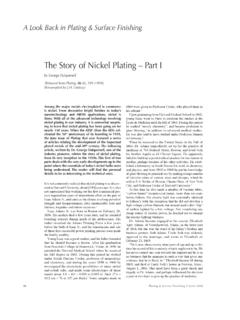Transcription of Against Transhumanism 1.0 - Soft Machines
1 Richard JonesEdition TranshumanismThe delusion of technological transcendencePrefaceiiAbout the authorRichard Jones has written extensively on both the technical aspects of nanotechnology and its social and ethical implications; his book Soft Machines : nanotechnology and life is published by OUP. He has a first degree and PhD in physics from the University of Cam-bridge; after postdoctoral work at Cornell University he has held positions as Lecturer in Physics at Cambridge University and Profes-sor of Physics at Sheffield. His work as an experimental physicist concentrates on the properties of biological and synthetic macro-molecules at interfaces; he was elected a Fellow of the Royal Society in 2006 and was awarded the Institute of Physics s Tabor Medal for Nanoscience in 2009.
2 His blog, on nanotechnology and science policy, can be found at Soft this ebookThis short work brings together some pieces that have previously appeared on my blog Soft Machines (chapters 2,4 and 5). Chapter 3 is adapted from an early draft of a piece that, in a much revised form, appeared in a special issue of the magazine IEEE Spectrum de-voted to the Singularity, under the title Rupturing the Nanotech Rapture .Version , 15 January 2016 The cover picture is The Ascension, by Benjamin West (1801). Source: Wikimedia Commons1 Transhumanism , technological change, and the Singularity4 Rapid technological progress progress that is obvious on the scale of an individual lifetime - is something we take for granted in the modern world.
3 The world I live in as a prosperous inhabitant of a developed and wealthy country is quite different to the world of my grandparents and great-grandparents. My everyday living conditions are comfortable, and I have the necessities of life food and shelter in abundance. I can travel even to the other side of the world with ease, I have access to devices for education and entertainment undreamt of a few decades ago, and when I fall ill or meet accidental injury, many con-ditions that would have been a death sentence in former times have cures, often quite straightforward ones. This technological progress has led to economic growth every year, in developed countries at the technological frontier, people work out how to do things a little bit better.
4 On aver-age this results in a percent or two more economic output each year, which compounds over the years to produce ex-ponential will this story unfold in the future? For some, it s a period of growth that won t prove sustainable, and so must come to an end. Perhaps we ll run out of the resources that underpin growth the easily accessible energy sources we ve come to rely on will run out sooner or later, or perhaps supplies of some element we ve come to depend on will run short. Maybe we ll cause our environment such irreversible damage, for example by setting off a runaway climate change event, that it will be no longer compatible with civilization. Less dramatically, we might just run out of good ideas, or the conviction to implement them, and growth and progress might slowly peter out.
5 Or our self-destructive tendencies might finally manifest themselves in a fi-nal and culture-destroying war, in which we turn the full destruc-tive force of our technologies Against pessimism isn t entertained by transhumanists, who re-gard the technological progress of the modern world as the har-binger of much greater change to come. An industrial revolu-tion has led to an information technology revolution, and this, in their view, has begun to change the very essence of what it means to be human. Our destiny, then, is for the technology we create to transform not just our way of life, but the essence of our existence. Perhaps and possibly within the lifetimes of those already alive - we will see new forms of human beings in which the biological and technological seamlessly merge.
6 Maybe we will be able to leave our biological forms behind en-tirely to take up an entirely new form of post-human are the new technologies that might enable such a funda-mental change? Transhumanists believe that these technolo-gies are already with us, or at least are conceivable on a time 5scale of years or decades. From current developments in infor-mation technology and particularly the acceleration of comput-ing power implied by Moore s law will come true artificial intelli-gence, an intelligence which surpasses human intelligence, and perhaps will subsume it. Meanwhile, they say, the realization of a radical vision of nano-technology [1] will grant us complete control of the material world, effectively eroding the distinction between software and hardware.
7 This, they anticipate, will end scarcity in all forms, leading to a world of material superabundance, and will lead to medical technologies of such power as to render death essen-tially of the first consequences of these new technologies, in their nascent forms, will to accelerate the progress of technologi-cal innovation itself. So what can we say about the future that this will lead us to?Transhumanists look forward to a technological singularity, which we should expect to take place on or around 2045, if Ray Kurzweil is to be relied on [2]. The technological singularity is described as something akin to an event horizon, a date at which technological growth becomes so rapid that to look be-yond it becomes quite unknowable to mere cis-humans.
8 In some versions, this is correlated with the time when, due to the inexorable advance of Moore s Law, machine intelligence sur-passes human intelligence and goes into a recursive cycle of self-improvement. The original idea of the technological singularity is usually cred-ited to the science fiction writer Vernor Vinge, though as we ll see later, earlier antecedents can be found, for example in the writing of the British Marxist scientist Bernal. Even amongst transhumanists and singularitarianists there are differ-ent views about what might be meant by the singularity, but I don t want to explore those here. Instead, I note this - when we talk of the technological singularity we re using a metaphor, a metaphor borrowed from mathematics and physics.
9 Let s be-gin by probing the Singularity as a metaphor. A real singularity happens in a mathematical function, where for some value of the argument the result of the function is unde-fined. So a function like 1/(t-t0), as t gets closer and closer to t0, takes a larger and larger value until when t=t0, the result is infinite. Kurzweil s thinking about technological advance re-volves around the idea of exponential growth, as exemplified by 6 Moore s Law, so it s worth making the obvious point that an ex-ponential function doesn t have a singularity. An exponentially growing function - exp(t/T) - certainly gets larger as t gets larger, and indeed the absolute rate of increase goes up too, but this function never becomes infinite for any finite t.
10 An exponential function is, of course, what you get when you have a constant fractional growth rate - if you charge your engi-neers to make your machine or device 20% better every year, for as long as they are successful in meeting their annual target you will get exponential growth. To get a technological singular-ity from a Moore s law-like acceleration of technology, the frac-tional rate of technological improvement must itself be increas-ing in time [3]. It isn t totally implausible that something like this should happen - after all, we use technology to develop more technology. Faster computers should help us design more powerful micro-processors. On the other hand, as the components of our micro-processors shrink, the technical problems we have to overcome to develop the technology themselves grow more intractable.


